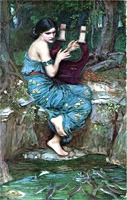Medb hErenn as Euhemerized Goddess
 The legendary Queen Medb of Ireland is sometimes described by mythographers as a euhemerized local goddess. There were many such in ancient Ireland, because the Gaels did not have a formal, organized pantheon like the Greeks. These goddesses were associated with specific locations, often the hillforts of clan chieftains or tribal kings, and they were sovereignty goddesses, meaning that they sanctified the rule of that chief or king. Usually the ruler had to mate with the goddess in a yearly ritual that both legitimized his rule and ensured the fecundity of his people and their land; in this way, the goddesses were also concerned with fertility. This mating could be symbolic in some fashion, such as getting drunk on mead, or it might involve a surrogate, such as the ruler's wife or favorite concubine, or a woman specially prepared by the Druids. In some rituals, however, the surrogate was a mare or a cow, or even the earth itself.
The legendary Queen Medb of Ireland is sometimes described by mythographers as a euhemerized local goddess. There were many such in ancient Ireland, because the Gaels did not have a formal, organized pantheon like the Greeks. These goddesses were associated with specific locations, often the hillforts of clan chieftains or tribal kings, and they were sovereignty goddesses, meaning that they sanctified the rule of that chief or king. Usually the ruler had to mate with the goddess in a yearly ritual that both legitimized his rule and ensured the fecundity of his people and their land; in this way, the goddesses were also concerned with fertility. This mating could be symbolic in some fashion, such as getting drunk on mead, or it might involve a surrogate, such as the ruler's wife or favorite concubine, or a woman specially prepared by the Druids. In some rituals, however, the surrogate was a mare or a cow, or even the earth itself.At these times, or when the ruler was ritually sacrificed for failure or weakness, or during the four prominent holidays of the Celtic year, the Druids would beseech the goddess to reveal to them the future, thereby associating the goddesses with prophecy and magic. At other times of the year, the goddesses also presided over combat and death, making them war and funerary goddesses. This is probably the origin of the Morrígan, the tripartite goddess of war, fertility, prophecy, and death.
I used all these ideas when I developed Medb hErenn's character. She is a skilled and well-trained warrior, bloodthirsty, a lover of combat, and would just as soon solve problems and win disputes with her fists or sword. She is hyper-promiscuous; not quite a nymphomaniac, but close. She makes love at the drop of a hat, and she will bed just about anyone: young or old, beautiful or ugly, man or woman, it makes no difference to her; only children are off limits. And while technically not into bestiality, some of the beings whom she has had intercourse with were more beasts than men. She is adept at various forms of magic, especially druidry, sorcery, and fairy magic, and has a prophetic ability, though it is somewhat erratic. She has no qualms about killing, even in cold blood, and is vengeful, spiteful, vindictive, and treacherous. Though neither immortal nor indestructible, she is a goddess in all but name only; indeed, the Celtic gods were like the Norse gods in that they could grow old and be killed, without magical means to protect them. This too is part of Medb's character.
But what does it mean to be "euhemerized"? It is based on the theory of Euhemerism, which was developed by Euhemerus, a fourth century B.C. Greek mythographer and skeptic. He suggested that the Classical Greek religion was based on real historical events which, through retelling and the addition of religious and cultural themes and motifs, became the myths that the Greek religion was based on. In other words, the Greek gods and goddesses were once real people who were elevated to the level of deities. A modern literary example of this would be Robert E. Howard's contention that the god Crom that his character Conan swore to had actually been an ancient chief, whose exploits had made him a figure of worship to later generations. The deification of Roman emperors after death is another example.
However, the process can also work in reverse: beings revered as deities can, over time, dwindle to larger-than-life legend and folk heroes. Mythographers have long speculated that the Tuatha Dé Danann, the Fir Bholg, and the Fomorians were once the gods of the Celtic ancestors of the Gaels or even of the prehistoric people the Celts displaced, who over time were reduced to mortal races. Further, these same mythographers believe the Danann and Fir Bholg dwindled still further to became the Faeries of Irish folklore, especially after the conversion of the Irish to Christianity. Similarly, the heroes of Irish mythology are believed to have been local gods and goddesses who were reduced in stature as more prominent deities displaced them.
So to say that Medb is a euhemerized local sovereignty goddess is to say that at one time she was worshiped by the people who lived around the hillfort at Rathcroghan as a symbol of fertility, life, and death, who blessed the king and his rule, but who could also curse him and blight his people if she was not properly revered. In time, though, her status was reduced until she became a legendary queen with superhuman powers and appetites.
Published on July 16, 2013 05:16
•
Tags:
medb-herenn, myth, sovereignty-goddess
No comments have been added yet.
Songs of the Seanchaí
Musings on my stories, the background of my stories, writing, and the world in general.
- Kevin L. O'Brien's profile
- 23 followers



